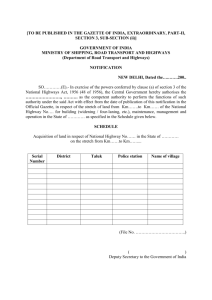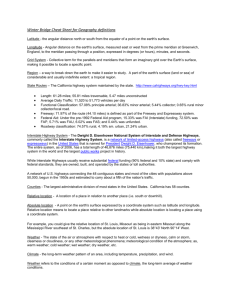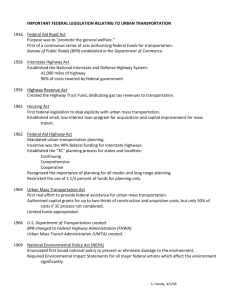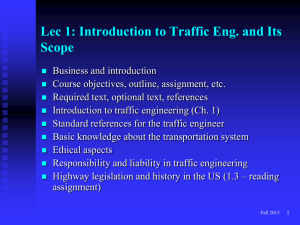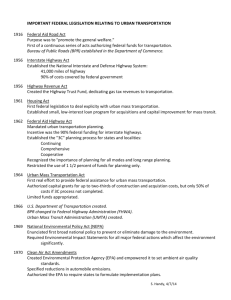Freight Transportation Policy
advertisement
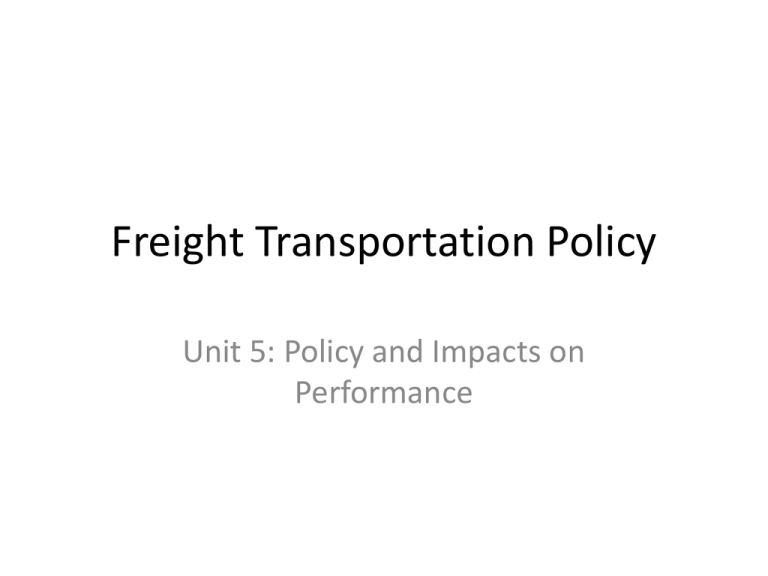
Freight Transportation Policy Unit 5: Policy and Impacts on Performance First, what is Policy? Policy at Different Levels • Individual Policies • I don’t eat meat. • I don’t walk home by myself after dark. • Family Policies • We eat dinner together every Sunday. • Curfew is midnight. • Organization Policies • HR policies (vacation time, salary, dress code) • Operating policies (safety, inventory, communication) • Government Policies • “Public policies” developed at all levels of government Public Policy “Public policy is the broad framework of ideas and values within which decisions are taken and action, or inaction, is pursued by governments in relation to some issue or problem.” - Stephen Brooks Public Policy in Canada: An Introduction Why do issues become subjects of public policy? • Meets one or more criteria – Scope: a significant number of people or communities are affected – Intensity: magnitude of impact is high – Time: has been an issue over a long period Policy Development Considerations • Public Interest What is in the best interest of society as a whole? • Effectiveness How well does a policy achieves its stated goals? • Efficiency How well are resources utilized in achieving goals and implementing policy? Policy Development Considerations • Consistency How well does policy align with broader goals and strategies of government? • Fairness and equity How well policy increases equity of all members and sectors of society (link to public interest)? • Reflective Does it consider other values and/or society and the community? Quick History Lesson: Federal Transportation Legislation • 1789 to the early 1800’s – federal role in transportation was minimal • First large transportation network in the US? • 4000 miles of canals (built btwn 1810 & 1860) • Subsidized by local and state governments, no federal funds • First federal expenditure on transportation? • Zane’s Trace – a postal road from Wheeling, WV to Limestone, KY • 1850 to 1900 – Age of the Railroads – 1838 – National government designated railroads as postal routes; miles of track grew from 3000 (in 1838) to 9000 by 1850 – National government subsidized RRs as a means of improving interstate commerce – Little incentive to improve/build roads outside of US cities – Canal system became almost non-existent • 1900 to 1956 – Cars come on the scene • What happened in 1902? • American Automobile Association (AAA) • Model T • Federal Road Act of 1916 • Lead to communication, standardization, uniformity • WWI – halted construction, but stressed the importance of a roadway network • Federal Highway Act of 1921 • “an adequate and connected system of roadways” • By 1930, over 23 million cars were on the road • 1900 to 1956 – Cars come on the scene • 1932 – First gas tax: 1 cent/gallon • Motor Carrier Act of 1935 – empowered the Interstate Commerce Commission to regulate trucking routes • States and local governments were still outspending the national government on highway projects • Every state imposed a state gas tax by 1929 • Federal-Aid Highway Act of 1944 • $20 billion for 40,000 mile interstate highway system • But WWII happened first National Interstate and Defense Highways Act • Formally, Federal Highway Act of 1956 • 41,000-mile national system of interstate and defense highways • Funded the “greatest public works program in history” • Centralized highway-policy making authority by elevating the role of federal and state government officials in determining the scope and nature of the country’s highway system • Completed by 1991 for $129 billion Between 1956 and 1991 • • • • • Mass Transit Highways and Suburban Sprawl Highways and Minority Neighborhoods Trucking Deregulation Environment & Citizen Involvement ISTEA (1991) • Intermodal Surface Transportation Efficiency Act • Major changes to previous policy • Interstate system complete, no shared goal • Congestion, pollution and sprawl increasing, infrastructure in poor condition • Increases in trade and need for intermodal collaboration • 6 years, $151 billion • Money allocated in ways which helped level the playing field between modes • States could split money between highway and mass transit – although this didn’t happen • Planning required - MPOs TEA-21 (1996) • Transportation Equity Act for the 21st Century • $167.1 billion for highways and $36.3 billion for mass transit over 6 years • Structure similar to that of ISTEA • Nearly $1 trillion spend on highways and bridges during the 90s • $160 billion on mass transit • Despite being given more freedom, only 9 states (including WA) made significant changes in their funding decisions SAFETEA-LU (2005) • Safe, Accountable, Flexible, Efficient Transportation Equity Act: A Legacy for Users • $244.1 billion • Targeted investment • • • • • • • • Safety Equity Innovative Finance Congestion Relief Mobility & Productivity Efficiency Environment Stewardship Environmental Streamlining MAP-21 • Still not authorized • Waiting since 2009 • http://blogs.asce.org/govrel/ • Needed: everything. “[T]he Act which I sign today is the most important transportation legislation of our lifetime ... It is one of the essential building blocks in our preparation for the future ... Transportation has truly emerged as a significant part of our national life. As a basic force in our society, its progress must be accelerated so that the quality of our life can be improved.” - President Lyndon Baines Johnson, signing the DOT Act, October 15, 1966. (photo courtesy of the LBJ Library via www.dotlibrary.dot.gov/Historian/historian) Department of Transportation Act • Established the US Department of Transportation (1966) • Mission “Serve the United States by ensuring a fast, safe, efficient, accessible and convenient transportation system that meets our vital national interests and enhances the quality of life of the American people, today and into the future.” (http://www.dot.gov/about_dot.html) US DOT (www.dot.gov) • Office of the Secretary • 10 individual Operating Administrations (most of which have ties to freight transportation) • • • • • • • • • • Federal Aviation Administration Federal Highway Administration Federal Motor Carrier Safety Administration Federal Railroad Administration National Highway Traffic Safety Administration Federal Transit Administration Maritime Administration Saint Lawrence Seaway Development Corporation Research and Innovative Technologies Administration Pipeline and Hazardous Materials Safety Administration But It’s Not Just the DOT’s Jurisdiction • Department of Agriculture • Agricultural Marketing Service (Transportation & Marketing Division) • Grain Inspection, Packers and Stockyards Administration • Department of Commerce • International Trade Administration (Office of Travel and Tourism Industries) • US Census Bureau • Department of Defense • US Transportation Command (TRANSCOM) • Department of Energy • Energy Efficiency and Renewable Energy Office But It’s Not Just the DOT’s Jurisdiction • Department of Homeland Security • Transportation Security Administration • Coast Guard • Department of Justice • Antitrust Division • Department of Labor • Occupational Safety and Health Administration • Bureau of Labor Statistics • Department of State • Bureau of Economics and Business Affairs • Transportation and Travel Management Division Federal Gas Tax • 18.4 cents per gallon • Revenue funds the Highway Trust Fund • Hasn’t been raised since 1993 • Concerns • Does not keep pace with inflation • Distribution among states (donor vs. donee states) • Earmarking State Gas Tax • Every state was on in addition to the federal gas tax • Highest: California (45.5 cents) • Lowest: Alaska (8 cents) • Washington: 37.5 cents History of the Federal Gas Tax Date Tax Rate (cpg) General Revenues Highway Account Mass Transit Account Other Trust Funds 1932 1.0 1.0 1933 1.5 1.5 1934 1.0 1.0 1940 1.5 1.5 1951 2.0 2.0 1956 3.0 3.0 1959 4.0 4.0 1983 9.0 8.0 1.0 1987 9.1 8.0 1.0 1990 (Sept) 9.0 8.0 1.0 1990 (Dec) 14.1 2.5 10.0 1.5 0.1 1993 18.4 6.8 10.0 1.5 0.1 1995 18.4 4.3 12.0 2.0 0.1 1996 18.3 4.3 12.0 2.0 1997 18.4 15.44 2.86 0.1 0.1 Highway Account Will Remain Solvent Until Next Year (2012), CBO Forecasts • The trust fund's Highway Account will run out of money in Fiscal Year 2013, however, if Congress does not authorize additional revenue, CBO forecasts. Transit programs -- paid for by the trust fund's Transit Account -can be fully funded into FY 2014, the report states. • "The two accounts will be unable to meet obligations in a timely manner sometime during 2013 (for the Highway Account) and 2014 (for the Transit Account)," according to the report. "From 2008 to 2010, the Highway Trust Fund received transfers from the General Fund of the Treasury totaling almost $35 billion to keep the trust fund from being exhausted." Reliance of Federal Spending Mode Generation of Revenue How Money is Spent Air •Aviation Taxes •FAA Appropriation ($15 billion) •Tickets/revenue •Air traffic control, airport improvements, general aviation airports Rail •Appropriation – National Railroad Passenger Corporation •FRA Appropriation ($1 billion) •Fares/tickets •Gas tax •Freight revenue •Amtrak ($500 million) Road •Gas tax ($30 billion federal) •DOT Appropriation •Roadways, transit Water ($1 billion) •Harbor maintenance tax •Inland Waterways trust fund tax •MARAD Appropriation ($.4 billion) •St. Lawrence Seaway Appropriation •Army Corps of Engineers O&M •Construction, feasibility, O&M •Passenger rail improvements •Transit projects Passenger Freight Air Ticket/fare Freight rate Rail Gas tax Ticket/fare Sales tax Gas tax Freight rate Road Water Gas tax Ticket/fare Gas tax Freight rate Gas tax (ferry) Freight rate *all DOT agencies receive appropriations in part funded by income tax Truck volume • Policies are generally focused on peak travel periods – Congestion – Air pollution • Truck volumes during the peak are small • Drivers tend to avoid congestion Concerns • Historically we have spent much more on highways than on other modes • How should the private sector pay for public infrastructure • Truly intermodal investments don’t happen due to siloed organizational structure at USDOT • Freight is a small percentage of overall traffic (typically less than 10%) Freight tends to struggle for funding • Canada’s Gateway and Corridors Program – http://www.pacificgateway.gc.ca/index2.html • Coalition for America’s Gateways and Trade Corridors – http://www.tradecorridors.org/ • Freight Act – Lack of funding mechanism State Level Policies • 3 distinct priority movements – Export – Import – Urban circulation • Supporting state-level trade • Disaster /resilience planning – Prioritization system – Communication system Municipal Scale Policies • Focus on air quality, safety, livability – anti-idling – Time-based restrictions – Truck size limits • Tend to add cost as opposed to improve velocity
